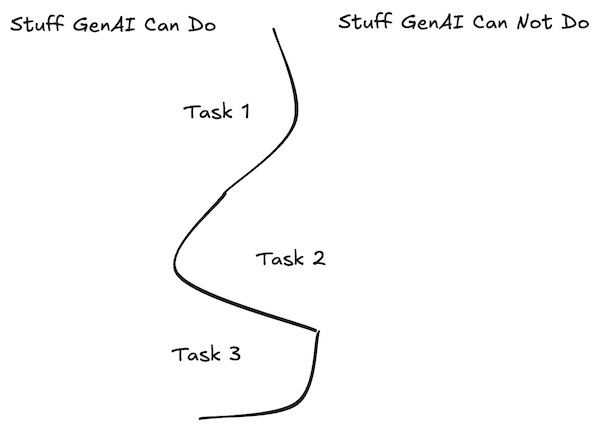The Jagged Frontier Is Personal
In an earlier post we looked at ways of viewing AI’s relationship with work. Part of the conversation looked at how the answer to how AI would disrupt the world of work turned on what we mean when we say work and how some components of work would be more impacted than others.
If we want to pull on that thread some more we need to make a distinction between what we call a ‘Job’ (formal roles, titles, a collections of responsibilities someone is entrusted with) and the tasks that are the components of activity within those jobs.
The Jagged Frontier
Looking at the tasks that can either be fully automated by AI, augmented by AI or would stump today’s AI, Ethan Mollick describes the concept of the ‘Jagged Frontier’ in his book Co-Intelligence. The discussion is based on work Mollick and co-researchers and Boston Consulting Group did for the 2023 working paper ‘Navigating the Jagged Technological Frontier: Field Experimental Evidence of the Effects of AI on Knowledge Worker Productivity and Quality’. Mollick also has a write up on his substack One Useful Thing.
The result is what we call the “Jagged Frontier” of AI. Imagine a fortress wall, with some towers and battlements jutting out into the countryside, while others fold back towards the center of the castle. That wall is the capability of AI, and the further from the center, the harder the task. Everything inside the wall can be done by the AI, everything outside is hard for the AI to do.
The concept is interesting and makes sense - the frontier of what AI tools can and cannot do is uneven, just as it is for individual people. An AI tool can be shown to be very good at some tasks (summarizing an earnings call transcript) and not so great at others (doing mathematics). The discussion in the book and the working paper discusses how navigating this ‘jagged frontier’ means experimenting to see which tasks one can delegate to AI, and which are best kept on our desks for now.

So far so good - we can look closely at the tasks of which a job is comprised to assess the impact of AI on that job through its impact on those tasks. This sounds like common sense, but is an often overlooked component in the discussion around ‘Will AI take my job?’.
What would you say ya do here?
The focus on tasks is a reminder of the discussions around outsourcing, and a useful related concept comes from the days of looking at the impact of offshoring on jobs. In a 2008 working paper (“A Replication Study of Alan Blinder’s ‘How Many U.S. Jobs Might Be Offshorable?”, Smith and Rivkin) the following description of a job is made:
A job is, in essence, a bundle of tasks that have been clumped together and assigned to an individual
The ‘bundle of tasks’ definition of a jobs has carried over to discussions about the impact of AI on occupations (see for example Hensenke et al, 2025)
Some things I think that Mollick gets at, and the ‘bundle of tasks’ discussions seem to be missing are the following:
-
‘Jobs’ are a collection of tasks, yes, but they are also a collection of responsibilities. Think of the rather aggressive business idiom ‘One Throat To Choke’. How do we assign responsibility (and the implied blame) to an AI that bungles a task? We just don’t right now. If the dog eats your homework it’s still on you.
-
Tasks are personal. The way you or I approach a task in our given bundle will vary, and so, perhaps will our estimation of an AI tools ability to perform that task well.
When Knowledge Workers perform tasks, they are not necessarily following a recipe step by step. They apply experience and Tacit Knowledge to get from A to B.
Tacit Knowledge
One of the most interesting scientific instruments built to date is LIGO, the Laser Interferometer Gravitational Wave Observatory. It is a a facility designed to detect and study gravitational waves, ripples in spacetime predicted by Einstein’s theory of general relativity.
Operation of such an instrument depends on detecting very small movements in mirrors. Given the minute scale of these movements, motion in the mirrors themselves due to thermal noise was of immense importance.
So teams of scientists set about measuring and evaluating the Q factor of various candidate materials. Q factor is a measure of a systems ability to vibrate at very particular frequencies, and a high Q translates to low thermal noise.
A group of Russian Researchers measured one of the candidate materials, Sapphire, to have very high Q. However these measurements could not be confirmed in the west for two decades, until finally replicated by a team in Glasgow in 1999. This twenty year delay was interesting enough to lead to a 2001 paper called ‘Tacit Knowledge, Trust and the Q of Sapphire’.
Tacit knowledge is personal, intuitive understanding and practical skills gained through experience that are difficult to articulate, codify, or transfer to others. In the case of the Q of Sapphire, the optimal “know-how” for measuring high Q factor was embodied in individuals rather than texts; without this, even having the right material and equipment was insufficient.
So where are you on the Jagged Frontier?
- Jagged Frontier = An AI tool will do very well on some tasks, not so great on others.
- Bundle Of Tasks = A ‘Job’ consists of many different tasks (tied together with responsibilities). An AI tool can do some of these tasks.
- Tacit Knowledge = Even then, it depends on how an individual approaches a task (and can document for an AI tool how to do so)
This last part is your own personal AI frontier, moving all the time. The only way to find out is to try some tools and see.